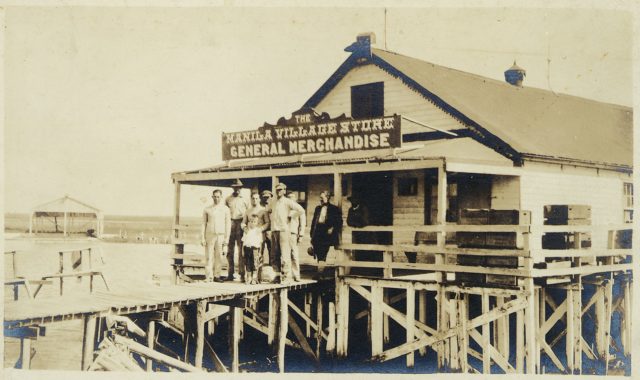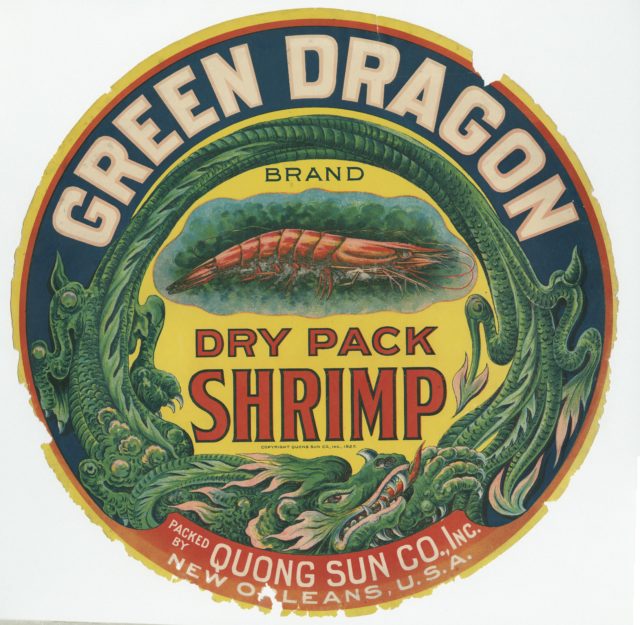Magazine
Shrimp Drying in Louisiana
A tale of industrial and political revolutions
Published: August 30, 2019
Last Updated: March 22, 2023

Photo by Charles L. Thompson, courtesy of LSU Special Collections
The “shrimp dance,” a shuffling circular dance over thoroughly dried shrimp to remove the shells from the meat, 1910s or 1920s.
In Louisiana, Chinese fishermen had introduced commercial shrimp drying to Louisiana by the early 1870s. The technology of the time limited commercial shrimping to shallow water, through the use of sailboats, rowboats, and cotton seine nets. Fishermen transported fresh shrimp to the processor, where the shrimp was boiled in salt and brine. Workers then spread the boiled shrimp two to three inches deep on drying platforms, covering them with tarps in rain and during the night, and turning over the shrimp every two hours to allow for even drying and less spoilage. After three days, teams of workers removed the shells by walking over the shrimp in a shuffling circle pattern known as the “shrimp dance.” Workers then used baskets to filter the powdered shrimp shells from the meat. Both the dried meat and shells were collected, as the powdered shells could be made into Filipino and Chinese cooking sauces, used to fertilize vegetable gardens, or sold as “shrimp bran,” an animal feed for hogs, poultry, and catfish. The dried shrimp meat went to the distributors at the Port of Orleans and was packed into barrels for shipment.
Louisiana itself formed a market for dried shrimp, using it in gumbo, jambalaya, and other rice dishes. The South America and the Caribbean also imported the product, particularly Cuba. However, the largest markets for dried shrimp were the Chinatowns of North America, including those in San Francisco and New York, and the cities of East Asia, especially China, whose cooks added dried shrimp to rice dishes, noodles, and stir-fried vegetables. While China produced dried shrimp, its demand surpassed its supply, especially after California banned dried shrimp exports in 1905.

The Manila Village Store served as general store and post office for the fishing settlement on Barataria Bay. Photo by Charles L. Thompson, courtesy of LSU Special Collections.
Most of the Louisiana merchants who owned shrimp distribution and processing companies were Chinese, though some of the largest companies were owned by non-Chinese Louisianans. As for the fishermen, census schedules indicate they represented many ethnicities, including the Chinese, Filipinos, Japanese, Italians, Croatians, Spanish-speaking Isleños, French-speaking Creoles, Cajuns from Southwest Louisiana, African Americans, and Native Americans.
In the twentieth century, technological innovations, such as the “otter trawl” and the gasoline motor, transformed the Gulf Coast seafood industry, allowing for greater catches at a lower cost and with less labor. In 1922, local Louisiana processors invented the mechanical shrimp shell separator, which ultimately replaced the shrimp dance, though drying still took place on platforms. Meanwhile, China, the primary market for Louisiana dried shrimp, avoided the worst effects of the First World War and the Great Depression, and their demand allowed Louisiana’s dried shrimp industry to prosper. A freighter arrived at the Port of Orleans almost every month to transport dried shrimp, Southern cotton, and American manufactured goods to Hong Kong, Shanghai, and the other port cities of East Asia. This continued until the Japanese invasion of China in 1937 and the occupation of Chinese cities during the Second World War.
Louisiana’s dried shrimp industry never recovered, and the Communist revolution in 1949 cut off the mainland Chinese market entirely. During the Cold War, dried shrimp distributors shifted their attention towards the domestic market, especially the growing Asian American market. Meanwhile, the domestic demand for frozen and fresh shrimp exploded after the Second World War, as Anglo Americans finally acquired a taste for shrimp, especially fried shrimp. In 1965, Hurricane Betsy destroyed many of the platforms where shrimp drying took place. Around this time, many of the remaining Chinese and Filipino fishermen abandoned the Louisiana shrimp industry for better-paying and less labor-intensive jobs in the cities.

Label for a barrel of dried shrimp from the Quong Sun company in the French Quarter, ca. 1927. The Historic New Orleans Collection.
By the 1970s, technological advances had made the Louisiana shrimp industry too efficient, and over-fishing had become a serious issue. Coastal erosion and the loss of habitat for shrimp and other sea life compounded the issue. To cope with the ever-decreasing shrimp catches, the state of Louisiana imposed a shorter shrimp season and limited commercial fishing to designated areas. In the 1970s, food safety agencies abolished the drying of shrimp on platforms, and since then, shrimp has been dried indoors using hot air from mechanical driers. During this time Vietnamese fishermen began settling in Southeast Louisiana, taking the place of earlier generations of fishermen. The Vietnamese are now one of the largest groups of shrimpers in the region.
In the twenty-first century, Louisiana dried shrimp continues to be produced from Gulf Coast shrimp, though on a smaller scale than in the 1930s. Asian immigration since 1965 has resulted in a flourishing demand for Asian groceries, including dried seafood, in every major city in North America. But like the rest of the seafood industry, Louisiana dried shrimp competes with cheaper foreign imports from Thailand, Myanmar, Vietnam, and, ironically, Mainland China, all countries with lower standards for environmental and food safety than the United States. Nonetheless, Louisiana dried shrimp continues to be distributed to markets around North America and around the world. Louisiana dried shrimp can be found in most Asian American supermarkets and Chinatowns, where it is marketed as “American shrimp,” setting the highest standard in taste, environmental sustainability, and safety.
Winston Ho is a graduate student in the Department of History at the University of New Orleans, specializing in early twentieth-century China and Chinese American history in New Orleans. Ho is the son of Taiwanese parents and a native of New Orleans.
